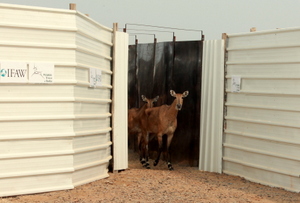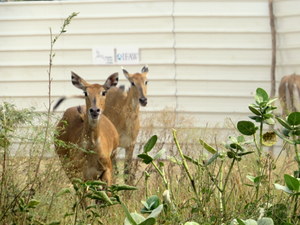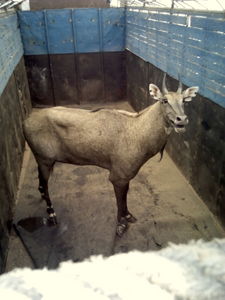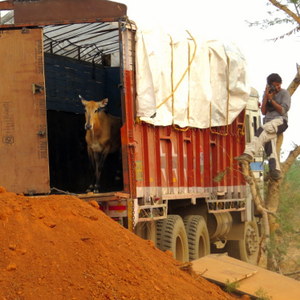First Time in India; Wild Nilgais Mass Captured and Translocated
Indira Gandhi International Airport, New Delhi, November 26, 2014:The Indira Gandhi International Airport (IGIA) is one of the major airports in the world, recently expanded to accommodate the ever-increasing passenger traffic. Set in a sprawling area of around 25 sq. km, the airport development authorities had to fence their campus to prevent intrusion of wildlife and humans, and were able to resolve the issue of human encroachment. However, a few nilgais (Boselaphus tragocamelus), inhabiting the city-side office premises, were entrapped in the airport operations zone which became a major cause of concern for the authorities.
In order to have a suitable solution, a series of meetings were held between representatives from Delhi International Airport Limited (DIAL), Delhi Forest Department and Wildlife Trust of India (WTI). After the initial assessment, IFAW-WTI was chosen to capture and translocate these nilgais from IGI Airport to Asola Wildlife Sanctuary, which after a site survey was selected as a suitable habitat for these animals. Based on assessment studies and almost a year-long survey, the team decided to capture the population by using ‘herd capture by habituation’ method as opposed to chemical capture. These had benefits over chemical capture, as the latter required a suitable drug that is currently difficult to procure in India. Moreover, through the herd capture, the entire herd can be caught together with minimal stress without risking the breaking of the herd (which was very likely in individual chemical capture).
The first step was to conduct a survey of the area for estimating the number of individuals present, document their habitat use and identify a suitable cluster for the capture. At least four to eight hours of monitoring at different intervals of the day was done in order to achieve this. During these surveys, it was noticed that a dynamic population of five-seven nilgais were visiting the airport rose garden and environs which had compound walls that could be used for the capture. “The nilgais preferred this area and were seen feeding on local vegetation at the site. But as availability of water was a major limiting factor, we decided to dig a water hole,” said Sandeep Juyal, Field Officer, Nilgai Translocation Project, WTI. Consequently, this site was chosen as the site to habituate the animals. Water and salt lick were used to attract the population. A capture tunnel was also constructed to facilitate the movement of the herd into the transport vehicle.
This site provided physical advantage as it had only one opening of 21m and was walled from all other sides. The capture boma was erected on the outer side of the targeted zone. This boma was erected using GI profile corrugated sheets screwed and nailed on iron angles and eucalyptus poles. These barricades were approximately 40m long running on both sides creating a passage for nilgais, while the other end of this boma opened up in the truck container. A curtained funnel was erected inside the targeted zone beginning from the entrance going diagonally till the far end of the targeted zone. These curtains were put up to reduce the area for movement of nilgais and also to avoid them from circling inside the zone while driving them towards capture boma.
The body of truck and the doors were specially fabricated for easy loading and unloading of the herd. Total of five nilgais were captured including one fully grown male, one sub-adult male and three females. On October 25, 2014, four nilgais were captured including three females and one sub-adult male. “Although the initial plan was to capture all the individuals, but we decided to capture the male the next day, noticing that he was injured and was not part of the herd,” said Abhishek Narayanan, Officer-in-charge, Wild Rescue and Rehabilitation, WTI.
All the captured individuals were then released in Asola WLS, New Delhi, and were monitored post release for few days. This was the first phase of capture and translocation. Further attempts will be undertaken after identifying and surveying other populations in coming months. “It is for the first time in India that wild nilgais have been mass captured and translocated. The experience gained in moving nilgais will come handy when WTI undertakes similar mass capture operations involving endangered taxa of ungulates,” said Dr NVK Ashraf, Director and Chief Veterinarian,WTI.













